Context:
This article is based on the news “Study finds high GHG emissions could turn continental shelves in Antarctic Marine Protected Areas severely acidic by 2100” which was published in the DownToEarth. A new study published in the Journal Nature Communications has raised concerns about the rising acidity levels of the continental shelves in Antarctic Marine Protected Areas (MPA).
GHG Emissions Could Turn Continental Shelves in Antarctic Marine Protected Areas Severely Acidic by 2100: Study
- Continental Shelves More Vulnerable: According to the study, continental shelves (shallow, underwater areas extending from the edge of continents) are expected to see more severe acidification than the open ocean.
- Impact of CO2 Emission: In the case of the high and very high emissions scenarios, there will be a widespread lack of aragonite (a type of carbonate mineral) saturation in the proposed and established MPAs by the end of the century.
- This undersaturation implies that organisms such as pteropods that form aragonite won’t be able to find places with stable conditions for their shells.
- MPAs: According to IUCN, it is any area of intertidal or sub-tidal terrain, together with its overlaying water and associated flora, fauna, historical and cultural features, which has been reserved by law or other effective means to protect part or all of the enclosed environment.
Marine Protected Areas in Antarctica
- Antarctic scientists have identified three key regions of the Southern Ocean around Antarctica in urgent need of protection.
- At present, a mere 5% of the Southern Ocean is designated protected.
- MPAs were instituted in the South Orkney Islands in 2009 and the Ross Sea region in 2016.
- Deliberations are underway to establish three additional MPAs in East Antarctica, the Weddell Sea, and the Antarctic Peninsula.
Marine Protected Areas in India
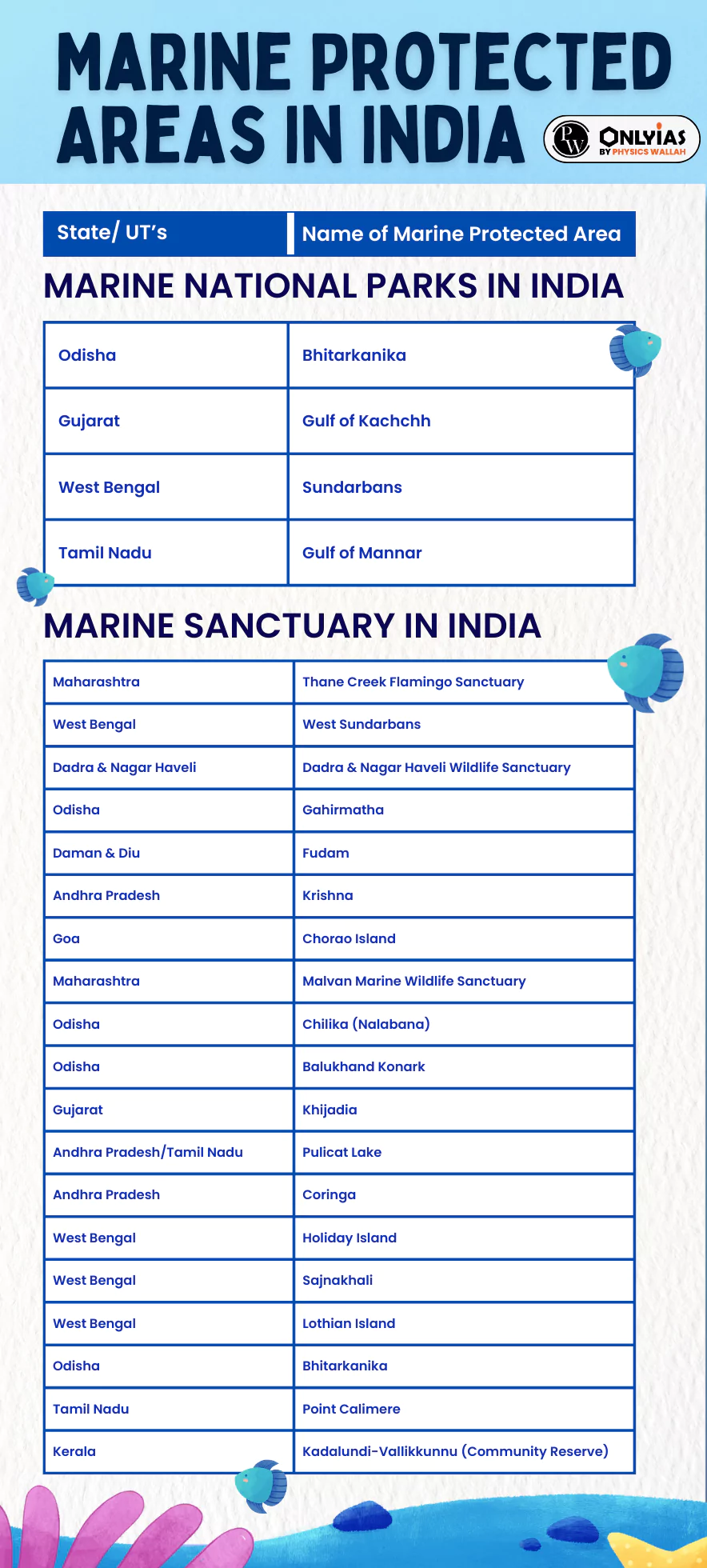
|
The pH Scale
- Scale: The pH scale runs from 0 to 14, with 7 being a neutral pH.
- Categorisation: Anything higher than 7 is basic (or alkaline) and anything lower than 7 is acidic.
- Hydrogen Ion Concentration: The pH scale is an inverse of hydrogen ion concentration, so more hydrogen ions translate to higher acidity and a lower pH.
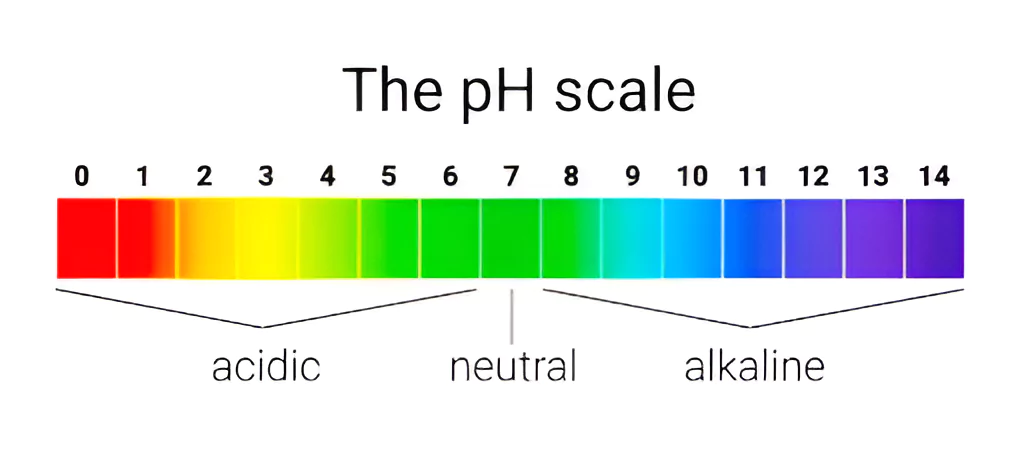
|
- Projection of Acidification: The study projected that the pH scale could decline by up to 0.36 for the top 200 meters of the ocean by 2100.
- Before the 18th to 19th century Industrial Revolution, the ocean’s average pH was about 8.2. Today, the ocean’s average pH is 8.1. This means that the ocean today is about 30 per cent more acidic than in pre-industrial times.
- By 2100, the pH of the ocean could decrease to about 7.8, making the ocean 150 percent more acidic and affecting half of all marine life, according to the Sixth Assessment Report of the Intergovernmental Panel on Climate Change (IPCC).
About Ocean Acidification
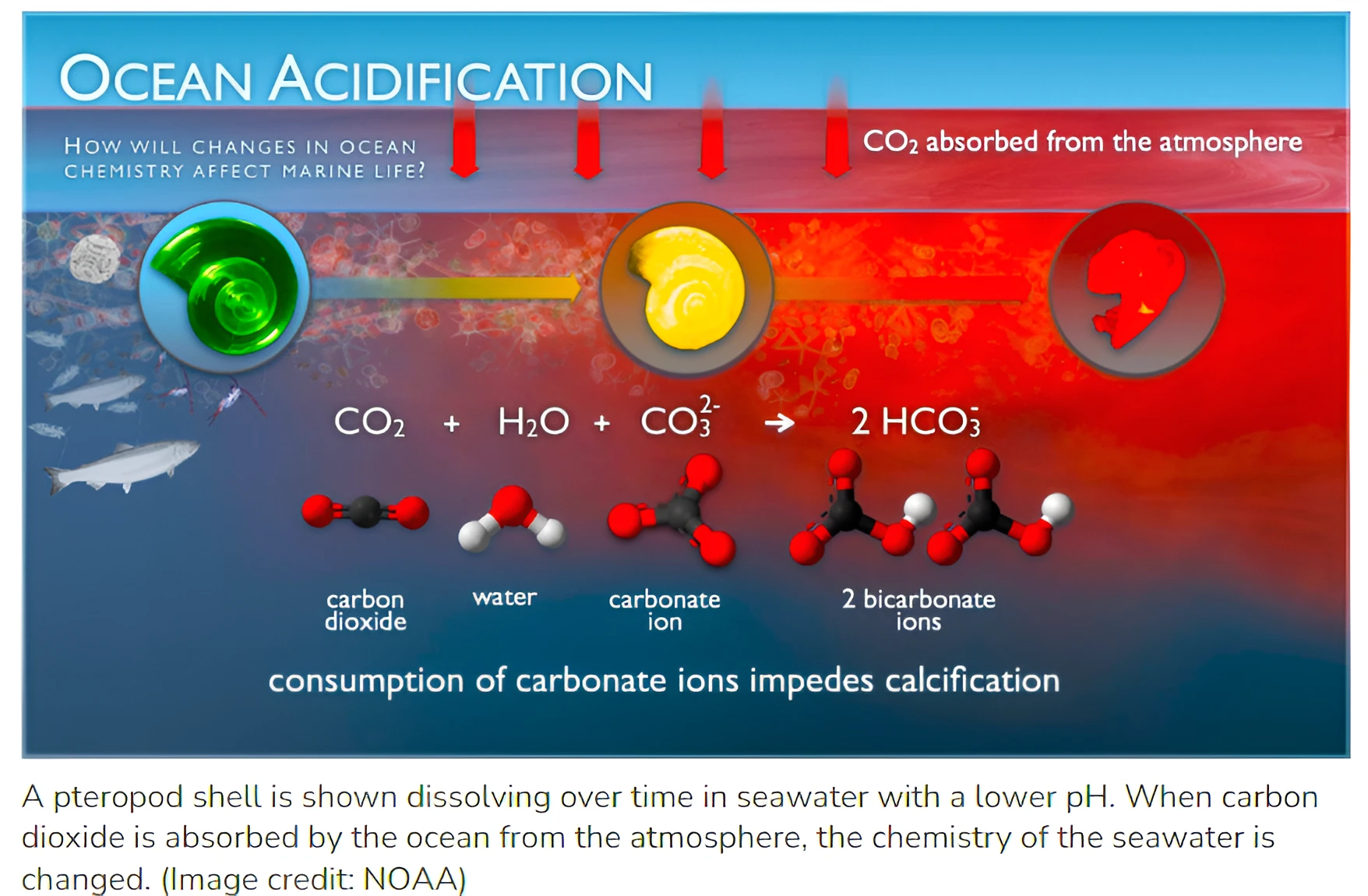
- Ocean Acidification: It refers to a reduction in the pH of the ocean over an extended period of time, caused primarily by the uptake of carbon dioxide (CO2) from the atmosphere.
- CO2 Absorption: The ocean absorbs about 30 percent of the CO2 released in the atmosphere increasing levels of Oceanic CO2 and acidification.
- The ocean helps mitigate the effects of global warming by absorbing some of the carbon dioxide gas (CO2) released into the atmosphere.
- This comes at a cost to ocean health because the uptake of anthropogenic CO2 causes acidification, which can harm marine ecosystems.
- Ocean Acidification Process: When CO2 is absorbed by seawater, a series of chemical reactions occur resulting in the increased concentration of hydrogen ions.
- Carbon dioxide dissolves into seawater and forms carbonic acid (H2CO3), a weak acid that breaks into hydrogen ions (H+) and bicarbonate ions (HCO3-).
- This increase in H+ causes the seawater to become more acidic and causes carbonate ions to be relatively less abundant.
What are the Causes of Ocean Acidification?
- Increasing Carbon dioxide Concentration in the Ocean: When sea organisms die on the sea beds, their remains pile up and form corals consisting of carbons.
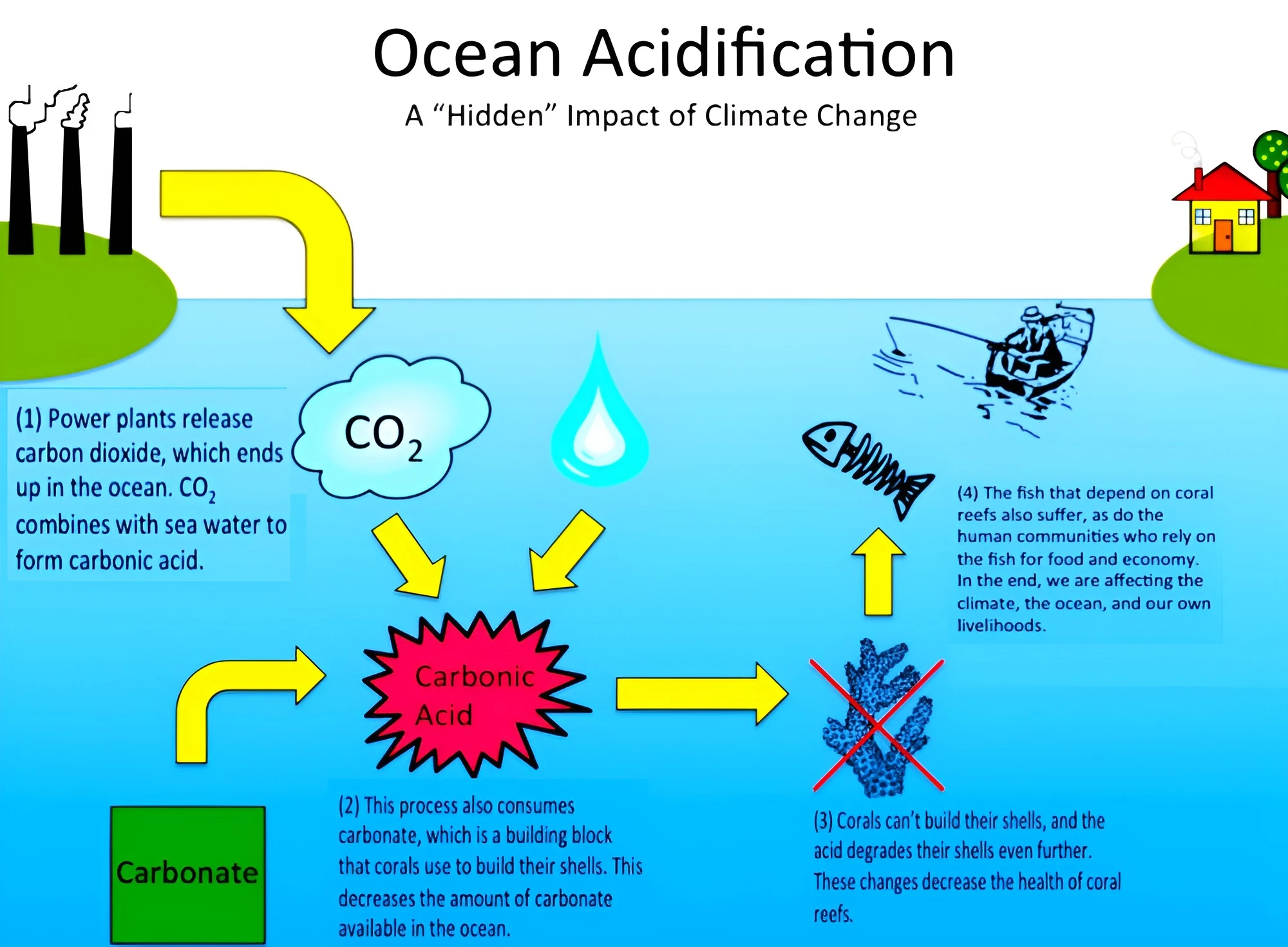 Increasing Carbon dioxide Concentration in the Atmosphere: Human activities such as the burning of oil, coal, and gas, as well as deforestation, are the primary causes of the increased carbon dioxide concentrations. CO2 contaminates the water by lowering the water’s pH and contributing to acidification.
Increasing Carbon dioxide Concentration in the Atmosphere: Human activities such as the burning of oil, coal, and gas, as well as deforestation, are the primary causes of the increased carbon dioxide concentrations. CO2 contaminates the water by lowering the water’s pH and contributing to acidification. -
- According to the Global Carbon Budget 2022, since the middle of the 20th century, annual emissions from burning fossil fuels have increased every decade, from close to 11 billion tons of carbon dioxide per year in the 1960s to an estimated 36.6 billion tons in 2022.
- Higher Concentration of Hydrogen Ions in Water: At the sea beds, some chemical reactions may take place, which may increase the hydrogen ions, when combined with other compounds such as nitrogen and water, among other gases.
- Emission Released During Burning Fossil Fuels: When burnt, petroleum, diesel, and coal produce lots of carbon dioxide, which finds a way into the water viz. through acidic rainfalls or even direct dissolving into the water.
- Other Reasons:
- Lack of Proper Waste Disposal: Using oceans as possible dumping grounds for domestic and industrial wastes. This waste is very dangerous as it lowers the PH of the ocean water.
- Rapid Industrialization: Growing industrialisation translates into increased carbon dioxide concentration in the atmosphere, which increases acidity when absorbed into the water.
Impact of Ocean Acidification on Oceanic Biodiversity
- Impact on Shell Builders: Carbonate ions are an important building block of structures such as sea shells and coral skeletons.
- Decreases in carbonate ions can make building and maintaining shells and other calcium carbonate structures difficult for calcifying organisms such as oysters, clams, sea urchins, shallow water corals, deep sea corals, and calcareous plankton.
- Impacts on Fish and Seaweeds: The ability of some fish, like clownfish, to detect predators is decreased in more acidic waters. Studies have shown that decreased pH levels also affect the ability of larval clownfish to locate suitable habitat.
- While some species will be harmed by ocean acidification, algae and seagrasses may benefit from higher CO2 conditions in the ocean, as they require CO2 for photosynthesis just like plants on land.
- Impact on Planktonic Ecosystems: The phytoplankton forms the basis of the marine ecosystems as it carries out photosynthesis and thus begins the chain of the marine ecosystems. So, if their photosynthesis faces a problem, the entire marine ecosystem suffers.
- Loss of Aquatic Life: Increased acidity leads to the disappearance or death of some organisms in the aquatic ecological environment.
Other Consequences of Ocean Acidification
- Increase in Carbon Dioxide Concentration in Ocean: Ocean acidification changes the gaseous concentration in the ocean, particularly carbon dioxide. The carbon gas then reacts with water molecules, forming carbonic acid.
- Rainfalls increase the concentration of carbon, which can potentially lead to suffocation and death of marine creatures.
- Food Shortage: When fish die, humans who depend on them for food and livelihood are hit by socio-economic problems.
- For instance, according to CoastAdapt, by 2100, the global annual costs of mollusc loss from ocean acidification could be over US$100 billion for a business.
- Food Web Disruption: Ocean acidification leads to the death and disappearance of some plants and animals in the sea. When some organisms become extinct, their dependents are also threatened because they have nothing to feed on.
- Tourism Decline: This industry could be severely affected by the impacts of ocean acidification on marine ecosystems.
- For example, increasing acidification may lead to a collapse of coral reefs. In Australia, the Great Barrier Reef Marine Park attracts about 1.9 million visits yearly, generating more than A$5.4 billion for the Australian economy.
Initiatives to Curb Ocean Acidification
- Rio+ 20 Summit: The United Nations Conference for sustainable development in 2012 stressed ocean acidification as a threat for the marine environment.
- The outcome document ‘the future we want’ highlighted the critical role the oceans play in all three pillars of sustainable development, and committment to protect, and restore the health, productivity and resilience of oceans and marine ecosystems.
- UNESCO IOC: The Intergovernmental Oceanographic Commission (IOC) of UNESCO is the custodian agency for SDG 14 Target 3, which is to minimize and address the impacts of ocean acidification.
- Through its role in supporting the Global Ocean Acidification Observing Network (GOA-ON), the IOC helps the Member States to coordinate the resources from different countries and organizations needed to understand and tackle the problem of ocean acidification.
- International Ocean Carbon Coordination Project (IOCCP): The IOCCP collaborates with the GOA-ON and other institutions to enhance the capability to observe and predict present-day and future responses of ecosystem processes, biogeochemistry, and climate change feedbacks.
- IAEA OC-ICC: The International Atomic Energy Agency (IAEA) established the Ocean Acidification International Coordination Centre (OA-ICC) in 2012 to focus on science, capacity building, outreach and communication about the status and trends of ocean acidification, promoting science-based decision making.
Also Refer: Global Coastal Adaptation Efforts: Gaps and Recommendations for Resilience
Way Forward
- Enhance Marine Protected Areas (MPAs): MPAs have been established at the South Orkney Islands Southern Shelf and in the Ross Sea region, with three additional MPAs proposed in the Weddell Sea, East Antarctica and along the western Antarctic Peninsula.
- If realized, this network of MPAs would protect around 60 percent of Antarctic shelf waters and India will continue to support setting up two MPAs in Antarctica to protect marine life and its ecosystem services,
- Continued Scientific Cooperation: Support and participate in international initiatives, such as the GOA-ON, to coordinate efforts in understanding and combating ocean acidification on a global scale.
- Further increase collaboration with organisations like the IOC of UNESCO and the IAEA to share knowledge and resources.
- Sustainable Fishing Practices: Encourage and enforce sustainable fishing practices to maintain balanced marine ecosystems and prevent the collapse of fisheries.
- Supporting the development and implementation of aquaculture practices that are resilient to changing ocean conditions, as increased acidity would make fish consumption a risky affair.
- Reducing the Consumption of Carbon-oriented Energy Sources: Carbon emitted from fossil fuels can be reduced by minimizing the use of such fuels.
- Thus there is a need for increasing adoption of the use of renewable energy sources, diversification of energy sources, such as solar and wind as alternative energy sources.
- Raise Awareness: Increase public awareness about the impacts of ocean acidification on marine ecosystems, emphasizing the importance of sustainable practices and reducing carbon footprints.
To get PDF version, Please click on "Print PDF" button.
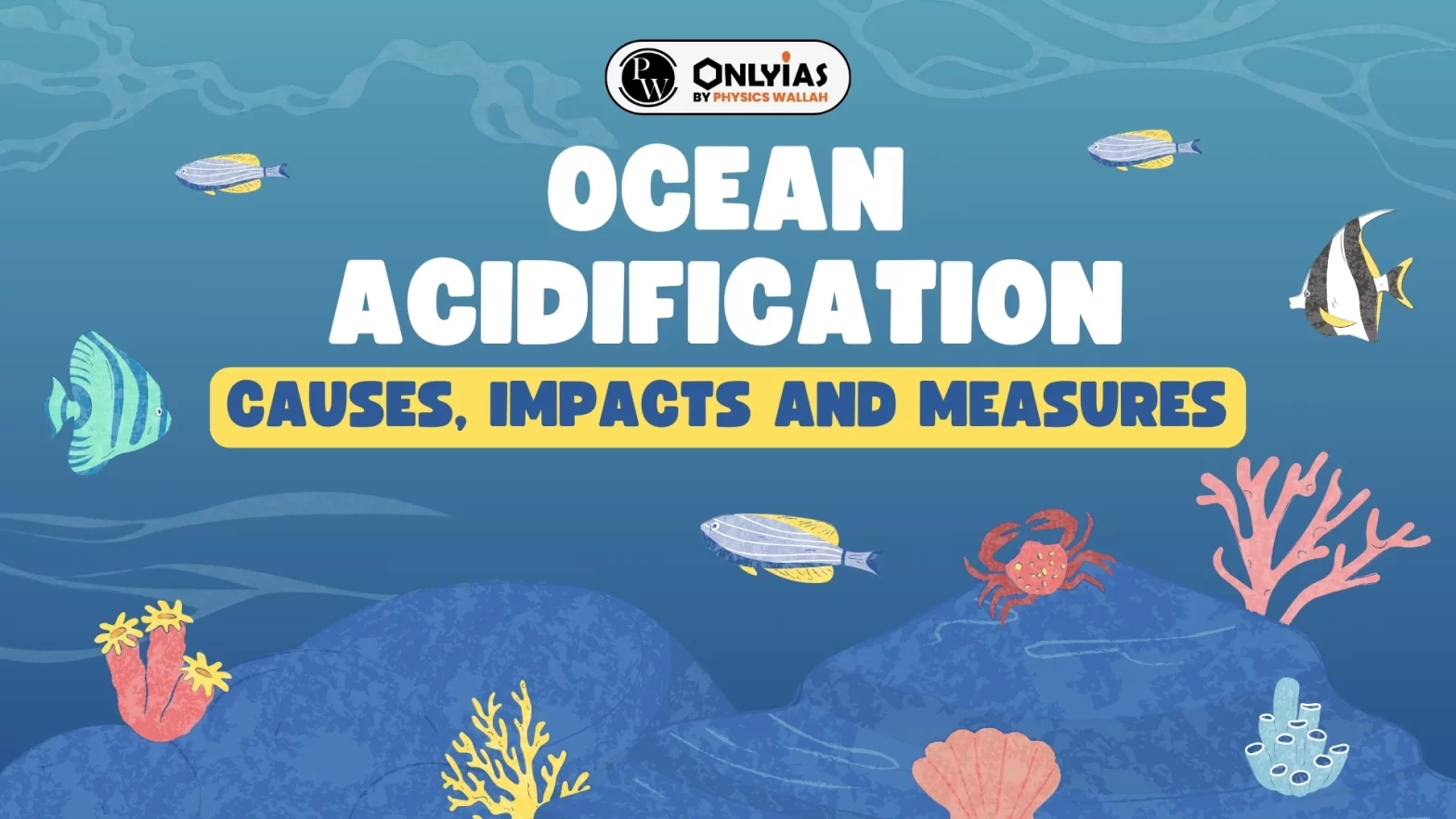

 Increasing Carbon dioxide Concentration in the Atmosphere: Human activities such as the burning of oil, coal, and gas, as well as deforestation, are the primary causes of the increased carbon dioxide concentrations. CO2 contaminates the water by lowering the water’s pH and contributing to acidification.
Increasing Carbon dioxide Concentration in the Atmosphere: Human activities such as the burning of oil, coal, and gas, as well as deforestation, are the primary causes of the increased carbon dioxide concentrations. CO2 contaminates the water by lowering the water’s pH and contributing to acidification. 